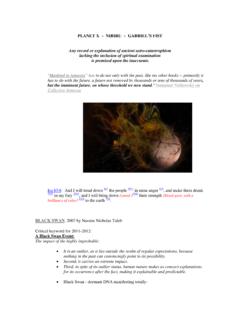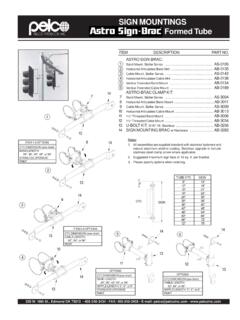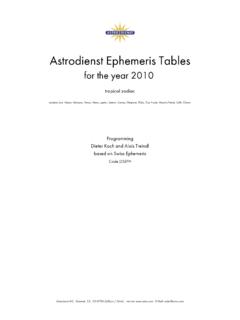Transcription of Chapter 4. Lagrangian Dynamics - Physics and …
1 56 Chapter 4. Lagrangian Dynamics (Most of the material presented in this Chapter is taken from Thornton and Marion, Chap. 7) Important Notes on Notation In this Chapter , unless otherwise stated, the following notation conventions will be used: 1. Einstein s summation convention. Whenever an index appears twice (an only twice), then a summation over this index is implied. For example, xixi xixii =xi2i . ( ) 2. The index i is reserved for Cartesian coordinates. For example, xi, for i=1,2,3, represents either x,y, or z depending on the value of i. Similarly, pi can represent px,py, or pz. This does not mean that any other indices cannot be used for Cartesian coordinates, but that the index i will only be used for Cartesian coordinates.
2 3. When dealing with systems containing multiple particles, the index will be used to identify quantities associated with a given particle when using Cartesian coordinates. For example, if we are in the presence of n particles, the position vector for particle is given by r , and its kinetic energy T by T =12m x ,i x ,i, =1,2,..,n and i=1,2,3. ( ) Take note that, according to convention 1 above, there is an implied summation on the Cartesian velocity components (the index i is used), but not on the masses since the index appears more than twice. Correspondingly, the total kinetic energies is written as T=12m x ,i =1n x ,i=12m x2+ y2+ z2() =1n.
3 ( ) Introduction Although Newton s equation F= p correctly describes the motion of a particle (or a system of particles), it is often the case that a problem will be too complicated to solve using this formalism. For example, a particle may be restricted in its motion such that it follows the contours of a given surface, or that the forces that keep the particle on the surface ( , the forces of constraints), are not easily expressible in Cartesian 57 coordinates. It may not even be possible at times to find expressions for some forces of constraints. Such occurrences would render it impossible to treat the problem with the Newtonian formalism since this requires the knowledge of all forces acting on the particles.
4 In this section we will study a different approach for solving complicated problems in a general manner. The formalism that will be introduced is based on the so-called Hamilton s Principle, from which the equations of motion will be derived. These equations are called Lagrange s equations. Although the method based on Hamilton s Principle does not constitute in itself a new physical theory, it is probably justified to say that it is more fundamental that Newton s equations. This is because Hamilton s Principle can be applied to a much wider range of physical phenomena than Newton s theory ( , quantum mechanics, quantum field theory, electromagnetism, relativity).
5 However, as will be shown in the following sections, the Lagrange s equation derived from this new formalism are equivalent to Newton s equations when restricted to problems of mechanics. Hamilton s Principle Hamilton s Principle is concerned with the minimization of a quantity ( , the action) in a manner that is identical to extremum problems solved using the calculus of variations. Hamilton s Principle can be stated as follows: The motion of a system from time t1 to t2 is such that the line integral (called the action or the action integral), I=Ldtt1t2 , ( ) where L=T U (with T, and U the kinetic and potential energies, respectively), has a stationary value for the actual path of the motion.
6 Note that a stationary value for equation ( ) implies an extremum for the action, not necessarily a minimum. But in almost all important applications in Dynamics a minimum occurs. Because of the dependency of the kinetic and potential energies on the coordinates xi, the velocities xi, and possibly the time t, it is found that L=Lxi, xi,t(). ( ) Hamilton s Principle can now be expressed mathematically by Lxi, xi,t()dt=0t1t2 . ( ) 58 Equation ( ) can readily be solved by the technique described in the Chapter on the calculus of variations. The solution is L xi ddt L xi=0,i=1,2,..,n. ( ) Equations ( ) are called the Lagrange equations of motion, and the quantity Lxi, xi,t() is the Lagrangian .
7 For example, if we apply Lagrange s equation to the problem of the one-dimensional harmonic oscillator (without damping), we have L=T U=12m x2 12kx2, ( ) and L x= kxddt L x =ddtm x()=m x. ( ) After substitution of equations ( ) into equation ( ) we find m x+kx=0 ( ) for the equation of motion. This result is identical than what was obtained using Newtonian mechanics. This is, however, a simple problem that can easily (and probably more quickly) be solved directly from the Newtonian formalism. But, the benefits of using the Lagrangian approach become obvious if we consider more complicated problems. For example, we try to determine the equations of motion of a particle of mass m constrained to move on the surface of a sphere under the influence of a conservative force F=F e , with F a constant.
8 In this case we have T=12mv 2+12mv 2=12mR2 2+12mR2sin2 () 2U= F R , ( ) where we have defined the potential energy such that U=0 when = =0. The Lagrangian is given by 59 L=T U=12mR2 2+12mR2sin2 () 2+F R . ( ) Upon inspection of the Lagrangian , we can see that there are two degrees of freedom for this problem, , , and . We now need to calculate the different derivatives that compose the Lagrange equations L =mR2 2sin ()cos ()+F R L =0ddt L =ddtmR2 ()=mR2 ddt L =ddtmR2 sin2 ()()=mR22 sin ()cos ()+ sin2 ()(), ( ) applying equation ( ) for , and we find the equations of motion to be F =mR 2sin ()cos ()()0=mR2sin () sin ()+2 cos ()().
9 ( ) Incidentally, this problem was analyzed at the end of Chapter 1 on Newtonian Mechanics (problem 2-2, with F =0), where Newton s equation was used to solve the problem. One can see how simpler the present treatment is. There was no need to calculate relatively complex equations like er. Furthermore, it is important to realize that the spherical coordinates and are treated as Cartesian coordinates when using the Lagrangian formalism. Degrees of Freedom and Generalized Coordinates If a system is made up of n particles, we can specify the positions of all particles with 3n coordinates. On the other hand, if there are m equations of constraints (for example, if some particles were connected to form rigid bodies), then the 3n coordinates are not all independent.
10 There will be only 3n m independent coordinates, and the system is said to possess 3n m degrees of freedom. Furthermore, the coordinates and degrees of freedom do not have to be all given in Cartesian coordinates, or any other systems. In fact, we can choose to have different types of coordinate systems for different coordinates. Also, the degrees of freedom do not even need to share the same unit dimensions. For example, a problem with a mixture of Cartesian and spherical coordinates will have lengths and angles as units. Because of 60 the latitude available in selecting the different degrees in freedom, the name of generalized coordinates is given to any set of quantities that completely specifies the state of the system.








